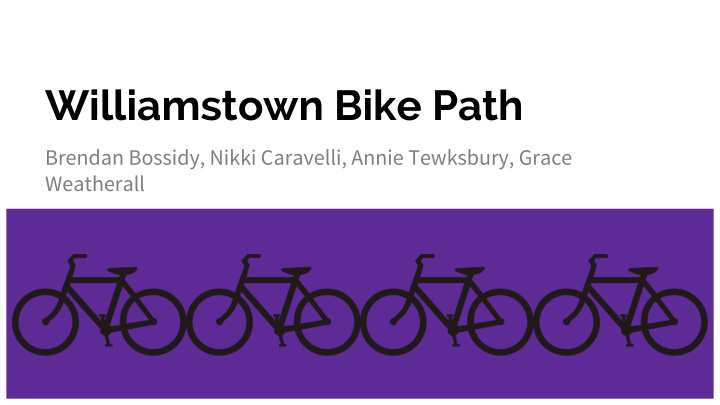



Williamstown Bike Path Brendan Bossidy, Nikki Caravelli, Annie Tewksbury, Grace Weatherall
Project Goals Design a bike path connecting ● South Street to Water Street Increase bikeability of campus ● and surrounding area Improve campus and town health ● and safety Work with College goal of ● addressing climate change by encouraging behavioral shifts
Background Current state of campus and town ● bikeability Future Downtown Developments ● Water Street ○ New Dorm ○ New Hotel ○ Science Center ○
Background Bikeability Study 2011 campus bikeability ● study Alta Planning + Design: ● nation’s leading active transportation firm
“This [path] is something I would use all the time.” Background “A dedicated bike lane would be fantastic.” Campus Survey Established ● demand for better biking spaces Established need ● for East-West route
Background Safety 19% Feel Unsafe Growing national problem ● Inadequate legal structure ● Williams College problem ● Need for education and ● promotion of bike culture Need for biking safety on ● campus
Section One
Section One
Section Two
Section Two
Section Three
Section Three
Section Four
Section Four
Design Standards Separate, off-road paths ● On-road one way lanes ● Separate Accommodation ○ Shared motor-bike lanes ○ Advisory lanes ○
Shared-Use/Bicycle Only Path (Off Road)
Separate Accommodation for All Users (On-Road)
Shared Bicycle/Motor Vehicle Accommodation (On-Road)
Advisory Bike Lanes (On-Road) 4-8 foot bike lane, 16 foot center travel lane, removal of median line ● No current laws or standards ● Ideal for narrow roads with low levels of traffic ●
Advisory Bike Lanes (On-Road) Used in heavily in Europe, Minneapolis, ● Edina, and planned for Portland Wave of the future in bike infrastructure ● Shown to reduce average speed of cars, ● increase cyclists on the road, and reduce accidents Good fit for roads on route: ● Narrow Roads ○ Future Increased Use ○ ■ Stetson Court Dorm ■ Hotel Advisory Lane in Minnesota ■ Water Street Development ■ Tourism
ADA Accessibility Rehabilitation Act of 1973 ● Americans with Disabilities Act of ● 1990
Bike Path Concerns ● Environmental Laws ● Economic and Financial Factors
Environmental Concerns ● Wetlands Protection Act ○ Riparian Buffer Zones ● Impermeable Surface Regulations ● Endangered Species Act
Economic Concerns ● Construction ● Obstacles
Bike Path Benefits ● Environmental ● Health and Safety ● Economic
Environmental Benefits ● Climate Change ● Decreased Driving
Health and Safety Benefits ● Increased Activity ● Fewer Traffic Accidents
Economic Benefits ● Global ● Cities ● Personal
Matrix Scoring 1 5 Good -------------------------------------------- Bad 1 --------------------------------------------------------- 5 Cost: Lowest Cost Highest Cost 1 --------------------------------------------------------- 5 Feasibility: Fewest Obstacles Most Obstacles 1 --------------------------------------------------------- 5 Environmental Impact: Least Environmental Impact Most Environmental Impact 1 --------------------------------------------------------- 5 Safety: Least Dangerous Most Dangerous 1 -------------------------------------------------------- 5 Desirability: Most Desirable Least Desirable 1 -------------------------------------------------------- 5 Accessibility: Most Access Least Access
Matrix On Road Options Off Road Options No Path Option A Option B Option C Option D Option E Cost Feasibility Environmental Impact Safety Desirability Accessibility Total
Section One
Section One Separate Accommodation for All Users Score: Cost 1, Feasibility 1, Environmental Impact 2, Safety 2, Desirability 2, Accessibility 1,
Section Two
Section Two Advisory Lanes Score: Cost 1, Feasibility 1, Environmental Impact 1, Safety 2, Desirability 2, Accessibility 1
Section Three
Section Three Advisory Lanes Score: Cost 1, Feasibility 1, Environmental Impact 1, Safety 2, Desirability 2, Accessibility 1
Section Four
Section Four Advisory Lanes Score: Cost 1, Feasibility 1, Environmental Impact 1, Safety 2, Desirability 2, Accessibility 1
Proposed Path
Option B
Further Recommendations General Bikeability Williamstown bikeability ● Water Street ○ Route 2 ○ Syndicate Road ○ Ashuwillticook/Mohawk ●
Further Recommendations General Bikeability Spring Street Contraflow Lane ● Spring Street two-way ●
Further Recommendations On-Campus Infrastructure Established need for bike racks ● and overnight storage “I find the lack of bike racks on campus extremely frustrating. Many buildings have no place to park a bike and others do but they are extremely overcrowded” -Survey Respondent
Further Recommendations On-Campus Infrastructure Lighting ● Safety education and on- ● campus biking information Signs and pavement markings ● Information on Advisory Lanes ●
Acknowledgements ● Interviewees: Andrew Groff ○ Rita Coppola-Wallace ○ Dave Boyer ○ Jason Hoch ○ Craig Wilbur ○ ● Sarah Gardner ● Survey Respondents ● Shaun Garvey
Recommend
More recommend